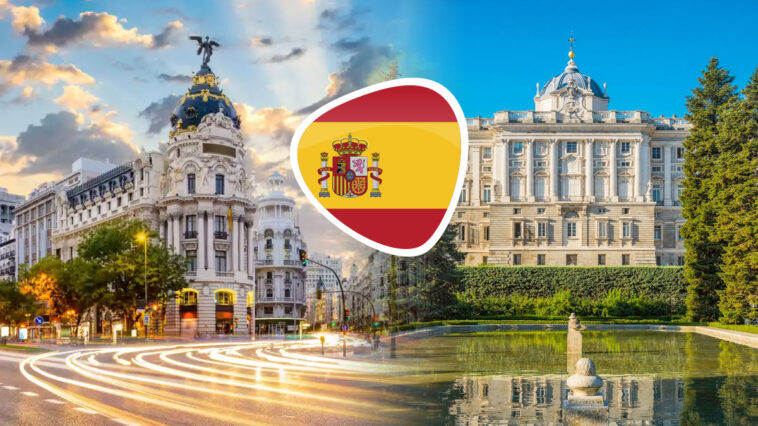In recent years, the casino industry in Spain has been thriving like no other place in Europe.
Madrid is the third-largest city in Europe that has a vibrant nightlife and excellent casinos. There are many incredible things to do and see.
With amazing architecture and history combined with a modern and glamorous vibe, you’ll be sure to find amazing food and things to do in Spain’s capital city.
Most of Spain’s best casinos can be found in Madrid, but you’ll also find casinos in Spain’s Mediterranean coastal towns as well.
Or if you happen to be traveling throughout Spain on vacation, and feel like getting in on some gaming action, here are some other Spanish cities where casinos are located: Barcelona, Marbella, Santander, Salamanca, Valencia, and Benalmadena.
If you’re 18 years old, you’ll be able to gamble in Spain. But be cautious, some of the competition at these particular casinos can be pretty tough. These are the absolute best casinos you’ll find in Madrid:
- Casino de Madrid. Since 1836, Spaniards have been gambling at this casino. One of the most top-rated casinos in Europe, this beautiful and palatial-style venue exudes class, so make sure to sport a jacket and tie. They have a great restaurant, several bars and offer blackjack, roulette, and slot machines.
- Casino Gran Via. Located on the Gran Via, a street full of restaurants, shops, and theatres, you’ll find three floors of slots and table games inside this iconic casino. They also have a dance club as well as several dining options. Games include blackjack, baccarat, slots, keno, punto banco, No-Limit Texas Hold’em, and Pot-Limit Omaha.
- Casino Gran Madrid Colon. Located in the center of town, this casino offers a large variety of gaming machines and table games. The slots have progressive jackpots that can cash out at over 15,000 euros. There are several different dining options that offer classic Spanish fare as well as Chinese and Japanese food.
- Casino Gran Madrid Torrelodones. With over 200 slot machines, 38 table games, and 25 poker tables, this is the largest casino in Madrid. There is live music on the weekends and three different restaurants to choose from. In addition to weekly No-Limit Texas Hold’em tournaments, they also have American-style roulette, Pot-Limit Omaha, blackjack, and keno.
After you’ve pocketed some euros, it’ll be time to check out some of the sites in one of Europe’s busiest metros.
1 – Royal Palace of Madrid
This is the ceremonial residence of the Spanish Royal family and the largest currently working palace in all of Europe. This massive structure contains 3,418 rooms.
Although the royal family spends most of their time in a much smaller palace outside of Madrid, the Royal Palace sometimes hosts other royals and holds gala dinners, but it is mostly used for tourism.
Construction on the palace began by the first Bourbon king of Spain, Felipe V in 1735, and was first occupied by King Carlos III in 1764. The last king to use it continuously was Alfonso XIII in 1931.
Inside the palace, you’ll find an exhibit of royal armory from the time of Emperor Charles V. This enormous collection of military artifacts is an example of a time when Spain was the most powerful empire in the world.
The building is also home to an amazing collection of paintings and frescoes by Spain’s most famous artists, including Francisco de Goya, Juan de Flandes, Caravaggio, and Velazquez.
Made of limestone and granite, the palace is surrounded by towering ionic and doric columns. All four sides of the building were dedicated to different subjects: the north to religion, the south to politics, the west to science, and the east to the military.
Inside, you’ll discover a ceiling fresco painted by Corrado Giaquinto that depicts Christianity being protected by Spain as well as a giant marble staircase that is flanked by two lions.
Surrounding the royal manor is a collection of impressive gardens that include the Sabatini and del Moro. The size of these gardens is more like that of a New York City park.
Throughout these gardens, you’ll find reflecting pools, marble fountains, and magnificent statues of Spanish and Gothic kings.
The cost of admission to the palace is 13 euros and is free on some days. In 2017, over a million and a half people visited the Royal Palace of Madrid.
2 – Gran Via
The Gran Via is the nerve center of Madrid’s nightlife full of plenty of high-end shops and entertainment venues.
This street houses row after row of magnificent buildings that contain cinemas and theatre venues as well as some of Madrid’s top night clubs.
There are many fantastic restaurants along this thoroughfare to visit when you want to take a break from real money gambling. You will not want to miss out trying some strawberry gazpacho, a Spanish omelet, or a traditional cocido madrileno, which is a chickpea-based stew made with meat and vegetables.
And like any major metropolitan street, there’s plenty of fantastic shops that include items from international designers and Spanish brands.
Be sure to check out El Corte Ingles, “The English Court.” This is Spain’s premier clothing store that offers brand names like Dior, Chanel, and Carolina Herrera.
Madrid locals usually don’t hit the Gran Via until about 10 PM, so you’ll find people buzzing about from all hours of the night.
The bars stay open all night, so you’ll be able to enjoy a cocktail and some tapas whenever the urge hits you.
It’s recommended to check out the bars that have balconies and rooftop terraces so you can enjoy the sights and sounds of Gran Via’s awesome street life.
3 – The Prado
Located in the heart of downtown Madrid is the main Spanish national art museum, The Prado.
Considered one of the best art museums in the world, it is home to over 7,000 paintings and 1,000 sculptures from the 12th to the 20th century.
It holds the single best collection of Spanish art in the world with works from artists like Francisco Goya, Diego Velazquez, Hieronymus Bosch, El Graco, Titian, and Peter Paul Rubens.
The most famous work displayed inside the museum is Las Meninas by Velazquez, in which several of the people in the painting are looking back out at the viewer of the painting.
Other highlights include Goya’s emotional depictions of the Spanish Civil War and Saturn Devouring His Son, which is gruesome and sometimes shocking to museum spectators.
Napoleon once used the Prado to house his cavalry and his supply of gunpowder during France’s occupation of Spain.
Over 2.8 million people visited the museum in 2012. General admission is 15 euros.
4 – El Rastro
El Rastro de Madrid is the most well-known open-air market in all of Spain and has been operating for the past 400 years.
“El Rastro” means “the trail” due to the fact that slaughtered animals were once dragged from the slaughterhouse to nearby tanneries, thus, leaving a trail of blood in their wake.
You can find goods from all over Europe and Africa at one of their 3,500 retail stalls where you’ll discover something new with every step.
People of different ethnicities come from around the world here to shop and hawk their trade. This is a market where people search out bargains on antiques and other hard to find items.
Be sure to come early if you want to see what they’re selling because there are always thousands of people who regularly show up.
Throughout this busy shopping excursion, you’ll be able to keep yourself fueled by visiting one of their many food stalls selling tapas and beers.
In addition to antiques and curiosities, you will be able to purchase Spanish-leather handbags, clothes, jewelry, and varying pieces of handicrafts and artwork.
The market is located on a street called La Ribera de Curtidores in the Central District of Madrid and is open every Sunday from 9 AM to 3 PM.
5 – Flamenco Tablaos
Flamencos tablaos are restaurants and dance halls that are dedicated to the music and dance of the flamenco style.
At one of these venues, you’ll be able to watch some of the best flamenco dancers in the world perform while you drink sangria and dine on such Spanish specialties as roast suckling pig, migas (which in Spain is fried bread with paprika), and jamon iberico.
Although the flamenco tradition originated in Andalusia and Murcia, it has thrived in Madrid over the past hundred years, and these dance halls became ubiquitous in Spain during the 1960s.
The highest quality flamenco clubs in Madrid were founded by flamenco dancers themselves. Here are a few of the best tablaos in Madrid: Los Carboneras, Villa Rosa, and Casa Patas.
Conclusion
What are some of the other highlights of Spain’s capital? Let me know what you think in the comments.
Michael Stevens
Michael Stevens has been researching and writing topics involving the gambling industry for well over a decade now and is considered an expert on all things casino and sports betting. Michael has been writing for GamblingSites.org since early 2016. …





